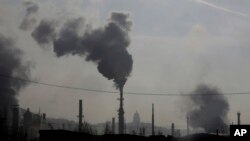A new study looks at air pollution and its effects on premature deaths in the United States. Premature deaths are defined as those that take place before the average age of death.
Researchers found that half of all such deaths related to air pollution resulted from pollution that came from another state.
The study is the first to estimate how pollution crossing state lines affects early deaths, says Steven Barrett. He is a professor at the Massachusetts Institute of Technology and a co-writer of a report on the study.
Worldwide, an estimated 4.2 million premature deaths are linked to outdoor air pollution. Most of those deaths are from heart disease, stroke and lung disease, as well as acute breathing infections in children, reports the World Health Organization.
Efforts to deal with outdoor air pollution have largely centered on relationships between local sources of pollution and local air quality. But Barrett and other researchers found that, in the United States, cross-state pollution is a major concern.
“Pollution is even less local than we thought,” Barrett said.
The computer model his team developed for the study looked at the atmospheric chemistry processes and weather conditions over an 11-year period. It then tied that information to information on human exposures and health risks.
The researchers then examined how each of the lower 48 states affects pollution and people’s health in every other state.
The model included records from 2005, 2011 and 2018 on different sources and kinds of pollutants. The pollution came from seven producers of emissions, including electric power stations, road transportation, shipping, railroads and airplanes.
The team found that electric power plants -- which release sulfur dioxide -- were the biggest contributor to deaths related to pollution from other states. In 2005, sulfur dioxide from power plants was involved in 75 percent of cases of premature deaths from out-of-state pollutants.
Net exporters and net importers
Not all states contribute to the problem equally, the study showed. Many states in the northern, middle part of the country, such as North Dakota, are “net exporters” of pollution-related health effects. That is in part because of their low populations in comparison to the amount of pollution they create.
Many states on the east coast are “net importers” of air pollution. New York is hit especially hard, with 60 percent of early deaths related to air pollution coming from out-of-state emissions.
Doctor Peter Muennig studies health effects of air pollution at Columbia University’s Mailman School of Public Health in New York City. He praised the new research.
“This is a great study,” said Muennig, who was not involved in the research.
A notable limit, he said, is that the information is based on models, which can be complex and more likely to contain mistakes.
Barrett said the researchers tried to measure areas of uncertainty in the models.
He said, “Like with climate change, not knowing the exact number doesn’t mean you don’t take action, because uncertainty cuts both ways and reality could be worse than our central estimates, as well as better.”
Barrett added that the team has a large amount of data that policymakers could use to try to lower the number of deaths.
The study was published this month in Nature.
I’m Ashley Thompson.
The Reuters news agency reported this story. Ashley Thompson adapted it for VOA Learning English. George Grow was the editor.
_______________________________________________
Words in This Story
Words in This Story
source –n. where something comes from
exposure - n. the act of coming into contact with some substance
contributor - n. something that provides or adds to a condition or situation
net - adj. describing an amount that has all reductions and additions accounted for
emissions - n. pollution or gasses that are released from factories or industrial centers
uncertainty –n. a condition of not being sure about something





